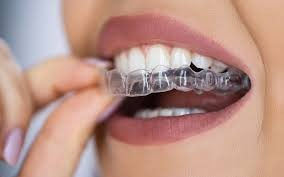Aligners and how to look after them..
- Emad Alzoubi
- Aug 2
- 4 min read

Keeping Germs at Bay
Bacteria, fungi, and viruses thrive in the warm, wet environment of the mouth. And when left unchecked, they can develop to the point of causing harmful side effects. Brushing, flossing, and using mouthwash at least twice daily is the best way to prevent these germs from multiplying. Just as plaque and tartar can form on the teeth, a build-up can accumulate on clear aligners, and maintaining them properly ensures the devices are kept in perfect condition.
Keeping Aligners Crystal Clear
Even if aligners are typically taken out when eating or drinking, some residue will migrate onto the devices when placed back in the mouth. Over time, this compromises the material’s transparency, suddenly making the aligners noticeable. It should also be pointed out that aligners that aren’t being kept clean can quickly develop odours that are difficult to remove.
Prolonging the Lifespan of the Devices
While aligners are only meant to be worn for a few weeks, they can get damaged quickly without proper care. That is why the practice is even more vital with retainers. What is a retainer for teeth? It is a device that keeps teeth in place post-orthodontic treatment. Unlike aligners, retainers are designed to be worn for years. This means people often wonder how to get a new retainer when they could learn how to prolong its lifespan instead.
How to Clean Aligners Every Day?
Clear aligners for adults, clear aligners for kids, with or without teeth attachments… whatever the type of device, a good cleaning routine is indispensable. It doesn’t need to be complicated, but patients must adhere to it without fail to avoid the issues cited above.
1. Rinsing
Let us be clear: rinsing an aligner is not cleaning it! It can be done throughout the day when taking it out or before placing it back in one’s mouth. Rinsing is also the first step in a proper cleaning routine, but it doesn’t stop there.
2. Brushing
For anyone wondering how to clean aligners effectively, brushing must be underlined as the most crucial step. This should be done using a soft-bristled toothbrush — which shouldn’t be the same one used for brushing the teeth — and antibacterial soap. Clear liquid soap is the best option. It will help remove debris or food particles that have accumulated during the day and kill harmful germs.
How to Deep-Clean Aligners?
In addition to daily maintenance, knowing how to clean aligners and sterilise them thoroughly whenever possible is essential. Some people do this nightly along with the brushing, while others prefer to do it every two to three days. The goal is to eliminate any bacteria that could have lingered after regular cleaning.
1. Soaking
This step consists in immersing the aligners in a cleaning solution designed to sterilise them completely. This removes stubborn plaque and keeps the devices fresh and clean. The choice of cleaning agent is crucial, as the wrong product could damage the material and make it porous, dull, or even brittle. Vinegar, rubbing alcohol, mouthwash, or denture cleaners are all unsuitable.
2. Cleaning Crystals
“Cleaning crystals” dissolve in water to create a suitable cleaning solution for aligners. The powder contains powerful cleansing agents designed to disinfect aligners without altering the material they are made of. To use them, the crystals should be placed in a dedicated tray along with the required amount of water and the aligners. After leaving the devices to soak for 3 minutes, they should be taken out of the sterilising solution, rinsed off, and brushed with warm water.
What Are the Mistakes to Avoid When Cleaning Aligners?
Knowing how to clean aligners also means understanding that some cleaning practices could do more harm than good. Unfortunately, simple cleaning mistakes could affect the material’s longevity and have negative effects on the patient’s oral health.
1. Using Hot Water
Plastic is a heat-sensitive material. Some people may know how to clean aligners and yet not realise that, while their method is good, the water temperature they use to rinse and soak their devices is too hot. Hotter than lukewarm, the water could warp the plastic. This changes its shape and the aligners may become uncomfortable or ineffective.
2. Using Toothpaste or Harsh Chemicals
Toothpaste, mouthwash, and other detergents (including vinegar and other natural alternatives) contain abrasive chemicals. These products may be very effective against bacteria, but they also weaken the aligners, making them more susceptible to plaque build-up. Aligners should only be cleaned using specifically designed cleansers.
3. Putting Aligners Back On Without Brushing and Flossing
This habit provides the perfect environment for bacteria to thrive and transfer from the teeth onto the aligners. This is why brushing and flossing systematically is important before putting the aligners back on.
4. Scrubbing the Aligners With a Hard-Bristled Toothbrush
The material that aligners are made from is resilient because it can exert enough force on the teeth to shift them into the correct position. However, it is also highly susceptible to scratching and surface damage, creating spaces for bacteria to grow. The best tool for cleaning aligners is a soft-bristled toothbrush.
Forgoing Regular Soaking
Soaking aligners in a cleaning solution (with cleaning crystals, for instance) is the only way to fully clear stubborn plaque build-up and ensure the devices remain fresh and clean.
Above all else, knowing how to clean aligners means understanding why it is such a critical practice. Patients who are aware of the consequences of not maintaining their aligners properly are more likely to adopt a thorough cleaning routine.




Comments